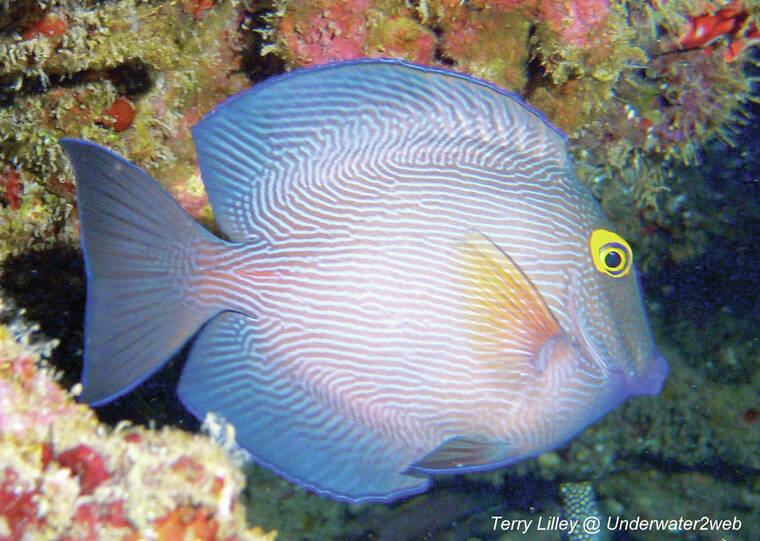Anyone who has dove in Hawai‘i more than likely has seen this attractive, six-inch-long fish, as they are quite common. But most people haven’t looked closely at its actual colors! “Kole” means “raw,” because people eat the fish without cooking it. But once the fish has been caught, it rapidly turns solid gray with its gold ring around the eyes. While scuba diving one day shooting some 4K video with my bright underwater lights, I shot a close-up of kole, and was amazed at the unique colors, and wondered why this fish developed such a stunning color pattern!
Anyone who has dove in Hawai‘i more than likely has seen this attractive, six-inch-long fish, as they are quite common. But most people haven’t looked closely at its actual colors! “Kole” means “raw,” because people eat the fish without cooking it. But once the fish has been caught, it rapidly turns solid gray with its gold ring around the eyes. While scuba diving one day shooting some 4K video with my bright underwater lights, I shot a close-up of kole, and was amazed at the unique colors, and wondered why this fish developed such a stunning color pattern!
Kole live close to the reef, and usually are found in small groups of two to five fish. They feed on algae, and are usually only a few feet away from a cave or crack in the reef, of which they dart into if threatened. Larger predator fish like the ulua love to eat the kole if they can catch them! Kole are not fast swimmers, so they developed a color that helps them avoid being eaten. They have very-thin, zebra-like stripes that bend onto their fins. When their fins go up and down the stripes change shape. The edge of their fins and mouth are electric blue. When the fish goes from sunlight into a dark cave, the stripes and blue colors cause the fish to almost disappear and totally change shape at the same time, which makes it very difficult for a predator to grab. The fish creates an optical illusion going from the sun to shadows, and is hard to follow. The stripes and blue edge on the fins makes the fish look much bigger than it is, and helps it avoid predators because it is always a few inches in front of where it was last seen.
Having a gold color around the eyes also helps the fish to reflect light away from its eye so it can go from the sun into a cave quickly and be able to see so it can avoid being eaten by a larger fish that takes a while to adjust to the changing light. Kole are beautiful, and there is a fun Hawaiian phrase sometimes given to an attractive person: “kole maka onaona,” which means “sweet-eyed kole!”
The fish is not wanting to be pretty. It just wants to keep from being eaten! The baby kole are bright yellow and often mistaken for a yellow tang. Kole are surgeon-fish because they have the sharp spike at the base of their tail. The baby kole have a dark spike, whereas the yellow tangs have a white spike, so this way you can tell them apart.
You can see the kole in action up on my YouTube in my Sharks Cove and Koloa Landing marine-life documentary movies up at Underwater2web. We will soon come out with a Maui and Molokini marine-life documentary movie and a whole series on Mexico’s marine life, including great white sharks!
•••
Terry Lilley is a marine biologist living in Hanalei and co-founder of Reef Guardians Hawai‘i, a nonprofit on a mission to provide education and resources to protect the coral reef. To donate to Reef Guardians Hawai‘i go to www.reefguardianshawaii.org.

Subscribe today for unlimited access.
Already a subscriber?
Login
Not ready to subscribe?
Register for limited access.
If you have a print subscription but require digital access,
activate your account.





